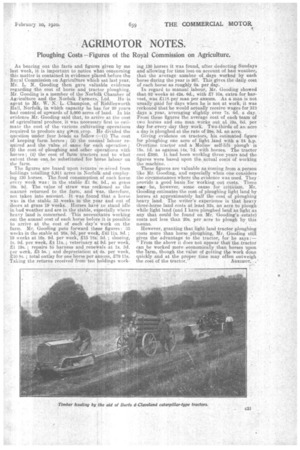AGRIMOTOR NOTES.
Page 19

If you've noticed an error in this article please click here to report it so we can fix it.
Ploughing Costs —Figures of the Royal Commission on Agriculture.
As bearing out the facts and figures given by m.e last week, it is important to notice what concerning this matter is contained in evidence placed.hefore the Royal Commission on Agriculture which sat last year. Mr. L. N. Gooding then gave valuable evidence regarding the cost of horse and tractor ploughing, Mr. Gooding is a member of the Norfolk Chamber of Agriculture and the Norfolk Farmers, Ltd. He ' is agent to Mr. W. N. L. Champion, of Riddlesworth Hall, -Norfolk, in which capacity he has for 26 years had control of upwards of 5,000 acres of land. In his evidence Mr. Gooding said that, to arrive at the cost of agricultural produce, it was necessary first to estimate the cost of the various cultivating operations required to produce any gi■ren,crop. He divided the question under four heads as follow :—(1) The cost of keeping farm horses ; (2) the manual labour re, quired and the value of same for each operation; (3) the cost of ploughing and other operations with horses ; (4) the cost of farm tractors and to what extent these can be substituted for horse labour on the 'farm.
The figures. are based upon returns r,i=L•eived from • holdings totalling 5,911 acres in Norfolk and employ. ing 130 horses. The food consumption of each horse every week was : in the stable 21 .6s. 5d., at grass 16s. 9d. The value of straw was reckoned as the manure returned' to the farm, and 'was, therefore, not taken into account. It was found: that a horse was in the stable 33 weeks in the year and out of doors at grass 19 weeks. Horses have to stand idle in bad' weather and are in the stable, especially where heavy land is -concerned. This necessitates working out the annual cost of each horse before it is possible to arrive at the cost of each day's work on the farm. Mr. Gooding puts forward. these figures : 33 weeks in the stable at 26s, 5.d. per week, 243 11s. 9d.; 19 .weeks at 16s. 9d. per week, 215 18s. 3d. ; shoeing, Is. 9d. per week, 24 us.; veterinary at 9d, per week, 21 19s. ' • repairs t-Oharness and renewals-at Is. 3d, per weell, 23 5s. ; and depreciation at 4S. per week, £10 8s. ; total outlay for one horse per annum, 279 13s.. Taking the returns received from ten holdings work ing 130 horses it was found, after deducting Sundays and allowing for time lost on account of bad weather, -that the average number of days worked by each horse during the year is 267. This gives the daily-cost of each horse as roughly 6s. per day. In regard to manual labour, Mr. Gooding showed that 52 weeks at 42s. 6d., with 27 10s. extra for har.vest, was L118 per man per annum. As a man is not usually paid for days when he is not at work, it was reckoned that he would actually receive wages for 313 days a year, averaging slightly ,over 7s. 6d. a day. Froth these figures the average cost of each team of two horses and one man works out at 19s. 6d. per day for every day they work. Two-thirds of an acre a day is ploughed-at the rate of 29s. 3d. an acre.
Giving evidence on tractors, his estimated figure for ploughing one acre of light land with a 24 h.p. Overtime tractor and a Moline self-lift plough is 15s. id. as against 14s, 7d with horses. The tractor cost 2380. It had been working three• years and the figures were based upon the, actual costs of working the machine, These figures are valuable as coming from a person like Mr. Gooding, and especially when one considers the circumstances where the evidence was used. They provide a good basisfor working out costs. There 'Ditty be, however, some cause for criticism. Mr. Gooding estimates the cost of ploughing light land by horses at approximately half the cost of ploughing heavy land: The writer's experience i.s that heavy three-horse land costs at least 325. odacre to plough while light land (and I have ploughed land as light as any that could be found on Mr. Gooding's estate) costs not less than 20s. per acre to plough by this means.
However, granting that light land tractor -ploughing costs more than horse -ploughing, Mr. Gooding still gives the advantage to the tractor, for he says : — From the above it does not appear that the tractor can be worked mote economically than homes upon the 'farm, though the value of .getting the work done quickly and at the proper time may often outweigh
the cost of the tract-or." AGIUMOT,






























